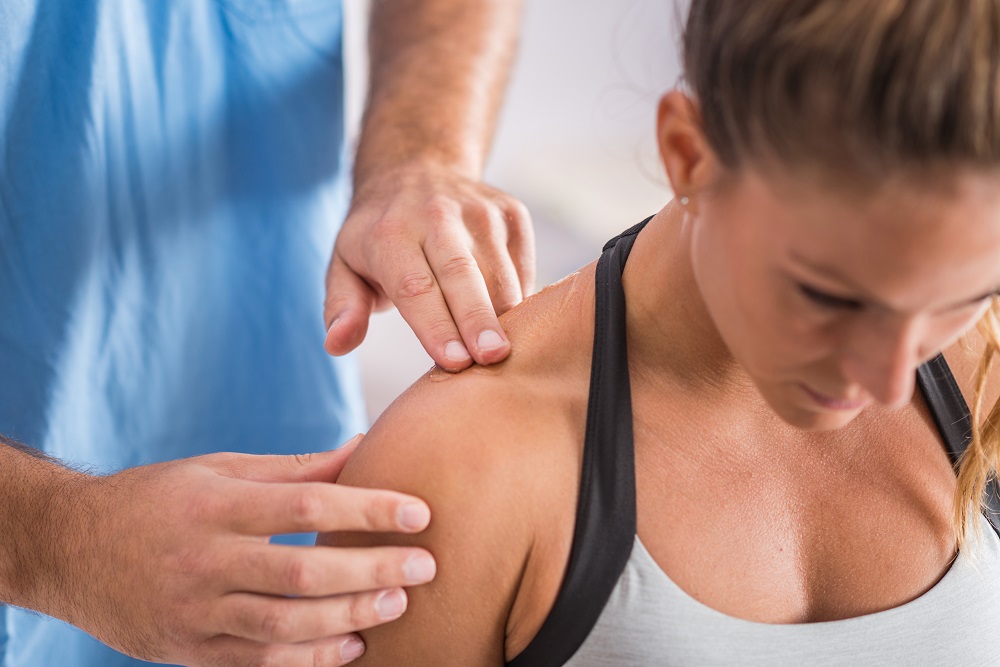The shoulder is one of the more complex joints in the human body. It has distinct characteristics that enable it to be the most mobile joint in the body, inherently making it the most unstable. The main function of the shoulder complex is to stabilize the arm and hand so they may interact with their environment. Injury to this joint can have drastic consequences. From the most basic tasks like getting dressed or brushing your hair to more complex movements like lifting weights or throwing a ball, the shoulder plays a major role in everyday function.
Understanding the Shoulder
To understand the complexities of the shoulder, we must first examine the anatomy. The shoulder comprises three bones: the humerus, clavicle, and scapula. It has three joints: the acromioclavicular (A-C) joint, the sternoclavicular (S-C) joint, and the glenohumeral (shoulder) joint. It also has one “pseudo” joint called the scapular-thoracic joint, where the shoulder blade rests against the ribcage. The shoulder has other structures, including ligaments, cartilage, and muscles, that work to move and stabilize the arm as it travels throughout all planes of motion. One such structure, the rotator cuff, is vital to shoulder function.
The rotator cuff is comprised of four small muscles that act as a stabilizer of the shoulder joint. The shoulder joint is classified as a ball-and-socket joint. Think of it as a golf ball sitting on a tee. The rotator cuff contracts during arm motion to compress the humerus’s head into the socket. In other words, the rotator cuff acts like four rubber bands holding the golf ball on the tee. Without the coordination of movement that these muscles perform, the arm does not maintain contact with the joint, and we see a mechanical breakdown of the shoulder— the golf ball wobbles on the tee. This breakdown can happen for a number of reasons, including a rotator cuff muscle tear, tendonitis, chronic inflammation, or shoulder weakness. All of these injuries can be treated with physical therapy.
Another dysfunction, impingement syndrome, is the most common cause of shoulder pain. People with shoulder impingement often complain of pain with reaching overhead, across the body, or behind the back and may have difficulty lying on the injured side. Shoulder impingement could result from poor posture, weakness, age, or repetitive overhead activities and can usually be resolved with specific strengthening exercises to improve shoulder mechanics.
A muscular flexibility and strength imbalance cause faulty scapular mechanics at the shoulder blade. This imbalance may cause scapular winging, where the shoulder blades protrude out rather than resting flat against the rib cage. Poor upper back and neck posture can also lead to a mechanical breakdown at the shoulder. This condition can occur in athletes, particularly those who participate in overhead sports such as volleyball, baseball, or swimming, due to the repetitive movement of the shoulder. There is also an increased incidence of shoulder injury in people whose jobs require prolonged time working at a computer.
A physical therapist can comprehensively evaluate the shoulder to determine the underlying cause of shoulder pain. Tests aim to identify faulty mechanics, assess the shoulder’s strength and range of motion, and perform special tests to rule out more serious injuries that may require additional medical intervention. Once a physical therapist has evaluated your shoulder, they can establish a plan of care based on exam findings. This may include a specialized strengthening program for the rotator cuff and postural re-education, flexibility training to address muscular imbalance, manual therapy to restore proper joint mobility, and pain management interventions.
If you are experiencing shoulder pain, schedule an appointment at any of our valley-wide clinics for a customized program, including education on proper body mechanics, as well as activities or positions that should be avoided or modified to allow you to transition back to the gym, return to sports, or resume normal daily activities with optimized shoulder function.






